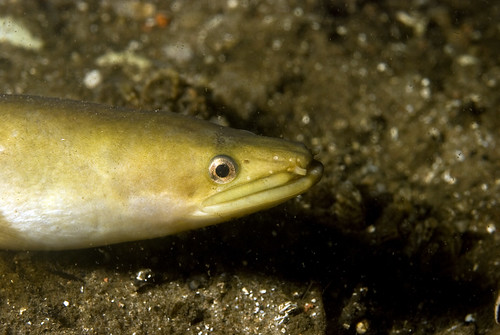
European eel, Spiegelplas;
(Photo by Arne Kuilman)
Over the last few posts, I have talked about the moray eels (F. Muraenidae), snake eels (F. Ophichthidae), conger eels (F. Congridae) and pike conger eels (F. Muraenesocidae). However, for people living in the temperate parts of North America, Europe, East Asia, Australia and New Zealand, where it comes to discussion of eels, the species that immediately springs to mind would most probably be 1 of the various species of freshwater eel (F. Anguillidae).
While many species of eel from other families are able to enter brackish and freshwater, and some even spend their entire lives in freshwater, it is the freshwater eels that are most famous for their ability to make the transition from a freshwater to a marine environment, and vice versa.
The most well-known species of freshwater eel is the European eel.

European eel;
(Photo by Ron Offermans)

European eels at Planet Neptune Oceanarium, St. Petersburg;
Elsewhere in the northern hemisphere, its counterpart on the other side of the Atlantic is the American eel (Anguilla rostrata), while the Japanese eel (Anguilla japonica) is found in East Asia.

Head of American eel;
(Photo taken from DCNature)
Along the east coast of Australia, south to Tasmania, live 2 species of freshwater eel, the shortfin eel (Anguilla australis) and Australian longfin eel (Anguilla reinhardtii). Both species also inhabit New Zealand, which has its own endemic freshwater eel species, the New Zealand longfin eel (Anguilla dieffenbachii).
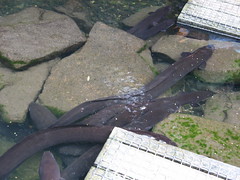
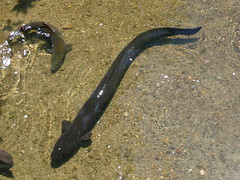
Shortfin eels at Willowbank Wildlife Reserve, Christchurch;
(Photo by karenmdnz)
New Zealand longfin eel at Pukaha Mount Bruce National Wildlife Centre, Wairarapa;
(Photo by newtestleopard)
While most freshwater eel species can exceed 1 metre in length, with several species reaching 1.5 metres, the Australian longfin eel is the giant of the family, with a specimen having been recorded at 2 metres.

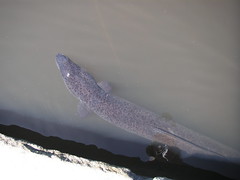
Australian longfin eel, Sydney;
(Photos by cskk and nikp044)
Although the most well-known freshwater eel species are those found in temperate regions, a large number of freshwater eel species actually live in the tropical Indo-Pacific region, from East Africa to India, Southeast Asia, and the islands of the South Pacific. Some species that can be found in Southeast Asian waters include the Indian mottled eel (Anguilla bengalensis), Indonesian shortfin eel (Anguilla bicolor), and marbled eel (Anguilla marmorata).

Marbled eel, Laos;
(Photo by Terry Warren)
The 18 species of freshwater eel are catadromous, which means that they live in freshwater as adults, but breed in saltwater. When sexually mature and ready to breed, freshwater eels stop feeding entirely; this journey is powered entirely by the stored fat reserves in their bodies. They swim downstream until they reach the sea. No obstacle seems insurmountable; eels trapped in lakes and ponds, or those that find their way blocked by dams or other barriers, will even travel overland at night, wriggling along until they find an unobstructed route to the sea. Their bodies gradually change as they enter the marine environment. Their eyes enlarge, enabling them to see in the dim light of the ocean depths. Their bodies take on a silvery sheen, providing countershading to protect themselves from oceanic predators as they travel to their spawning grounds. Due to this change in coloration, eels in this stage of life are known as 'silver eels'.
Based on what we know about some of the more well-known species, each species appears to have its own specific spawning ground; for the European eel and American eel, it is the Sargasso Sea. For the Japanese eel, its spawning ground is to the west of the Mariana Islands. The shortfin eel, Australian longfin eel and New Zealand longfin eel spawn in the southwest Pacific, around New Caledonia. There is still much to discover about the reproduction and life history of these eels; we do not know how the adults manage to find their spawning grounds, for example, nor has anyone ever observed the eels pairing up and spawning. It is believed that after spawning, the eels, having used up the last of their reserves, die.
The eel larva (known as a leptocephalus) spends some time following the ocean currents, before swimming closer inland and changing into the next stage of its life cycle, the glass eel, named for its semi-transparent body.

Leptocephalus stage of Japanese eel.

Glass eel stage of American eel.
As the glass eels grow, they enters freshwater and travel upstream, often in huge numbers. The following photos of young American eels, taken from the excellent Taunton River Journal, clearly illustrate that the young eels' journey is no less arduous than that undertaken by their parents.

Mass of glass eels below a dam.
Once again, no obstacle seems insurmountable; the tiny baby eels swarm over barriers, or emerge from the water to crawl overland, even scaling low waterfalls and the vertical walls of dams. As they continue to grow, they gradually develop pigmentation, and are now known as elvers.

Mass of elvers and glass eels.


Left: Glass eels and elvers emerging from the water to scale the wall of a dam.
Right: Glass eels climbing vertical wall.
The eels' journey ends when they find a suitable area for them to settle down, one with an ample supply of food and with adequate hiding places. Eels will travel overland to reach lakes and ponds, or enter underwater tunnels to reach water bodies otherwise cut off from other rivers or streams. Once established in a suitable habitat, they mature into adults (known as 'yellow eels'), and will feed on a wide array of smaller creatures, ranging from insects, crustaceans, worms and molluscs, to fish and frogs. After at least a decade, depending on the species, the now sexually mature eels make the return trip to the sea, back to where their journey began so many years before, thousands of kilometres away. Some individuals never make the trip back to the ocean; instead, they remain where they are, and continue to feed and grow. A study of otoliths (bones in the ear) indicates that some New Zealand longfin eels may live for as long as 100 years!
Jellyman, D. J. 1995. Longevity of longfinned eels Anguilla dieffenbachii in a New Zealand high country lake. Ecology of Freshwater Fish, 4(3), 106-112.
Eel life history

Freshwater eel life cycle
Many freshwater eel species are displayed in public aquaria, usually in the countries where they are native. And so, North American aquariums may display American eels, while New Zealand aquariums may display New Zealand longfin eels.
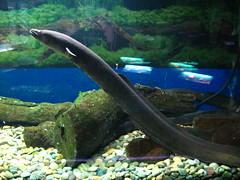
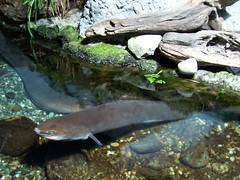
Left: New Zealand longfin eel at Otago Museum, Dunedin;
(Photo by impactdixon)
Right: New Zealand longfin eel at Kelly Tarlton's Underwater World, Auckland;
(Photo by coderkv)
Quite a few species of freshwater eel, such as the American eel and Japanese eel, are also offered in the aquarium trade from time to time. Like their marine cousins, these eels will need lots of space and hiding places, and a secure lid to prevent escape. In captivity, they can live for a very long time; a female European eel named Putte that died in 1948 at the Hälsingborg Museum, Sweden, was said to be 88 years old.

Apparently, some people living in parts of New Zealand have 'pet' eels which reside in ponds and creeks near their homes.
(Photo by Happysmurfday)
Interestingly enough, while doing research for this post, I discovered that freshwater eels can become surprisingly tame around people. In New Zealand, visitors to several parks and nature areas can actually feed the eels. The eels eagerly congregate at the water's edge, and will even wriggle onto land to take food from people's hands.

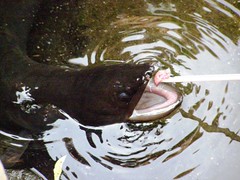
Feeding the shortfin eels at Willowbank Wildlife Reserve, Christchurch;
(Photos by arjones and kboardmoran)
It's a lot like how people in Singapore love to feed the fish in our ponds, but I guess the feeding programs in New Zealand are meant to help sensitise people to the need to protect eels, especially the endemic longfin eel.
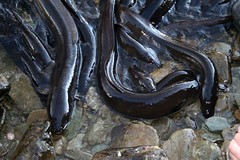
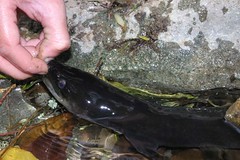
Left: Eel feeding at Waitomo;
(Photo by milkthebasic)
Right: Eel feeding at Wilderness Lodge Lake Moeraki;
(Photo by nrsa1)
However, the most important use of freshwater eels is as food. Virtually every species of freshwater eel supports some sort of fishery. Eels are commonly smoked before consumption, while jellied eels is a traditional English dish. Even the young glass eels and elvers are eaten as a delicacy.
Of course, no post about eels as food is complete without mention of unagi (鰻). I am very fond of unagi myself, although I am quite reluctant to indulge my cravings in future, now that I have learnt about the unsustainability of unagi.
A number of freshwater eel species are experiencing population declines, due to a combination of pollution, interference with migration, overfishing, and in the case of the European eel, the accidental introduction of a parasitic nematode worm (Anguillicola crassus) from East Asia. Most of the unagi originates from eels raised and fattened on farms. However, these eels were caught from the wild as glass eels, so technically, wild stocks are still being depleted, and in fact, are being deprived of potential breeders. These farms also create numerous other problems, from harvesting of vast quantities of fish in order to feed the eels, to pollution of wetlands due to the large amounts of waste released by these farms, to the spread of diseases to wild populations.

Farming of Japanese eel, Shizuoka;
(Photo by Charles Helsley)
The demand for unagi is so great that even European eel and American eel are being harvested, in addition to the Japanese eel. Both the European and American eels are already threatened to some degree by pollution and damming, and the harvesting of eels for the Japanese market definitely isn't helping to boost the wild population. In fact, European eel numbers are said to be dangerously close to collapse, with populations having plummeted by more than 90%. Similarly, the American and Japanese eels have undergone dramatic declines. The Australian and New Zealand species are also being exploited for the Japanese market, although it remains to be seen if the fisheries for these species can be managed well enough to minimise the risk of overexploitation.

Unagi don
(Photo by Fenchurch!)
Coming up in the final post in this series, I will briefly talk about 2 little-known eel families, the false morays (F. Chlopsidae) and spaghetti eels (F. Moringuidae). Also, stay tuned for a bunch of eel-like fish that actually aren't eels at all.
Part 1: Moray eels (Muraenidae)
Part 2: Snake eels (Ophichthidae)
Part 3: Conger eels (Congridae) and Pike conger eels (Muraenesocidae)
Part 4: Freshwater eels (Anguillidae) (this post)
Part 5: Spaghetti eels (Moringuidae) and false moray eels (Chlopsidae)
Part 6: Non-eels